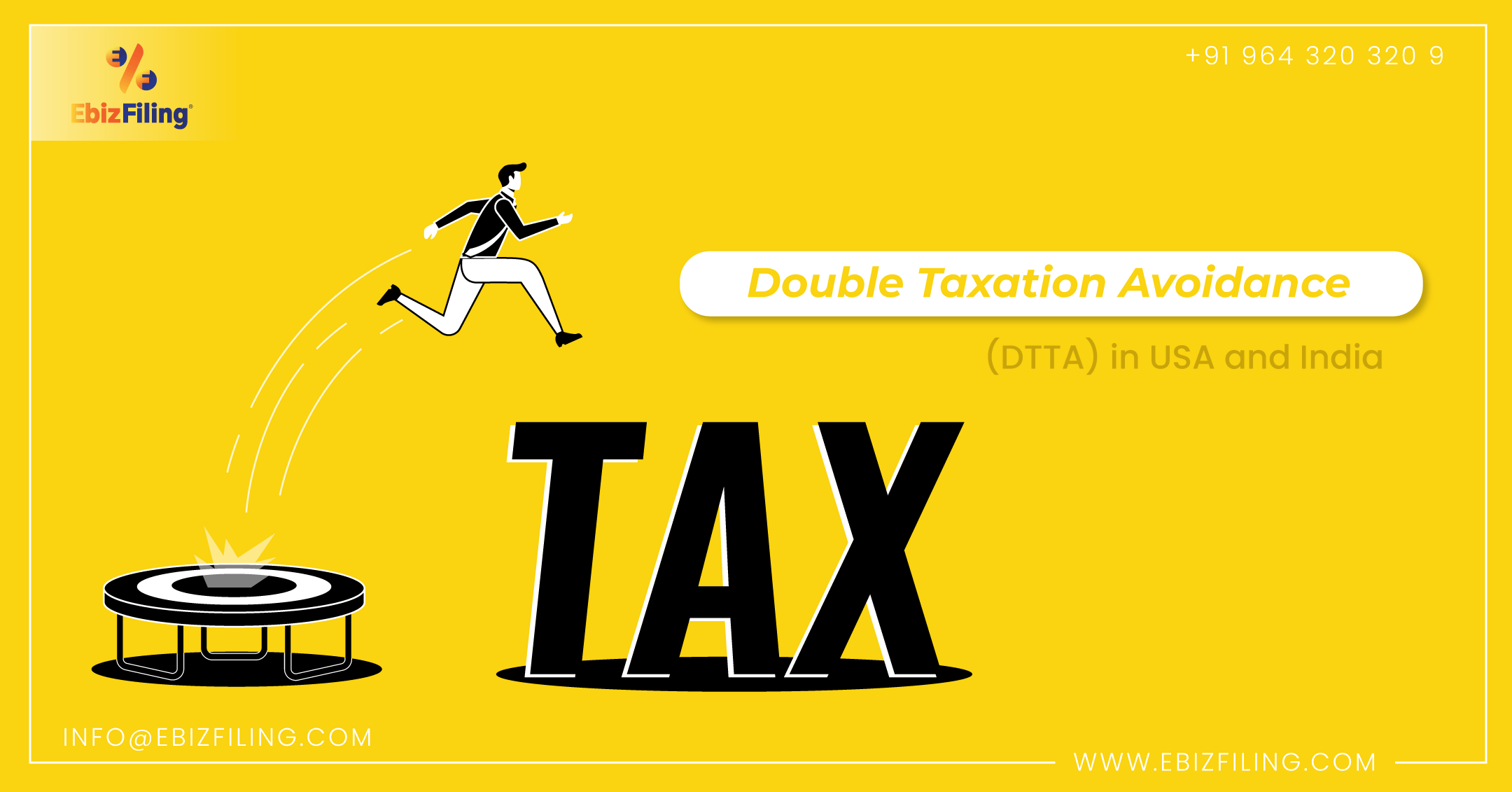
-
April 4, 2022
What is DTAA? Applicability of DTAA between India and USA and Documents required to take advantage of the DTAA
The Double Tax Avoidance Agreement (DTAA) is a tax treaty signed by two or more nations to assist taxpayers in avoiding double taxation on the same income. When a person is a citizen of one country but makes money in another, a DTAA becomes relevant. In this blog we will walk you through what is DTAA, DTAA between India and USA, DTAA between India and USA for salary income, and information on which corporation uses a double layer of taxation.
Table of Content
Introduction
The Indian government has engaged into the Double Tax Avoidance Agreement (DTAA) with a number of nations in order to avoid double taxes on income and to relieve taxpayers of excessive hardship. A DTAA (Double Tax Avoidance Agreement) between India and the United States tackles and eliminates the incidence of double taxation of income on people who earn money in both countries. Taxpayers should be aware that the India-US DTAA exclusively covers income tax. For GST (Goods and Service Tax) and other types of indirect taxes, there is no DTAA agreement between India and the United States.
What is DTAA?
The Double Tax Avoidance Agreement (DTAA) is a tax treaty signed by two or more nations to assist taxpayers in avoiding double taxation on the same income. DTAAs can be either comprehensive, encompassing all sources of income, or specific, e.g., taxing income from shipping, inheritance, air travel, and so on. India now has DTAA agreements with over 80 nations, with intentions to sign more in the coming years. Australia, Canada, the United Arab Emirates, Germany, Mauritius, Singapore, the United Kingdom, and the United States of America are among the countries with whom it has comprehensive agreements.
Applicability of DTAA between India and the USA
Individuals, trusts, partnership firms, companies, and other entities with income in both countries are covered under the DTAA between India and the United States. The following taxes are covered by the DTAA:
-
The Internal Revenue Code, sometimes known as the USA Income Tax, imposes a federal income tax in the United States.
-
India’s income tax system includes surcharges and surtaxes.
Advantages of DTAA between India and the USA
-
The goal of a Double Tax Avoidance Agreement is to make a country appear more appealing to investors by offering exemption from double taxation.
-
This relief is offered by exempting income generated in a foreign country from taxation in the resident country or by providing credit for taxes paid abroad.
-
Reducing the likelihood of tax avoidance in one or both of the signatory countries.
-
Reductions in tax rates.
-
Lesser Withholding Tax: Taxpayers benefit from lower withholding tax since they can pay less TDS on their interest, royalty, or dividend income in India.
Documents required to take advantage of the DTAA’s benefits
To take advantage of the DTAA’s provisions, an NRI must deliver the following documentation to the appropriate deductor in a timely manner.
-
A copy of your PAN card that has been self-attested
-
Proof copy from the PIO (if applicable)
-
A copy of your passport and a self-attested visa
-
Certificate of Tax Residence
DTAA between India and USA for Salary Income
Profits from Immovable Property
If a resident earns money from immovable property, they must pay taxes in the country where the property is located. The types of income derived from the immovable property are as follows:
-
Immovable property income is used to provide independent personal services.
-
Income from agriculture or forestry.
-
Rental income from immovable property.
-
Immovable property income is a source of income for a business.
Interest
Interest income earned in one nation and remitted to a resident of another country is taxed in the country in which the receiver resides. For example, interest income earned by a US resident in India is taxed in the United States.
However, interest may be taxed in the nation where it is earned, and if the taxpayer is a resident of the receiving country, the tax on the dividend cannot be more than:
-
If the interest is paid on a loan from a bank or financial institution, it is 10% of the gross amount.
-
In any instance, 15% of the gross amount is required.
Dividend
If a resident firm pays a dividend to a non-resident, the dividend income is taxed in the nation where the payout is received. For example, if a US corporation distributes a dividend to an Indian resident shareholder, the payout is taxable in India.
However, the dividend may be taxed in the sending nation, and the tax on the payout cannot exceed the following if the taxpayer is a resident of the receiving country:
-
If the dividend receiver owns at least 10% of the voting stock of the corporation issuing the dividend, the dividend is worth 15% of the gross amount.
-
In every other situation, 25% of the gross amount.
Income earned from Professors, Researchers, Teachers, and Scholars
If a professor, teacher, or research scholar goes to another nation, their income is tax-free if they meet the following criteria:
-
The contract is for a duration of not more than two years, And
-
The individual must be a resident of the first nation before the visit.
Residual Status of an Entity
A resident is a person who is obligated to pay tax according to the relevant laws of each country because of their residence, citizenship, domicile, place of management, place of incorporation, or other similar factors. If a taxpayer is a citizen of both India and the United States, his or her residence should be determined as follows:
- The taxpayer would be a permanent resident of the country where a permanent residence is available. If a taxpayer has a permanent residence in both areas, they will be considered a resident of the country with which they have the closest personal and economic ties.
- If the taxpayer does not have a permanent residence in either country, he or she will be considered a resident of the country where he or she has his or her habitual habitation.
- The taxpayer would be a resident of the country in which he or she is a national whether he or she had a usual abode in both nations or none of them.
- If the taxpayer is a citizen of both nations or neither, the competent authorities of both countries will decide on the taxpayer’s residency status.
Elimination of Double Taxation
In the United States, people will be able to claim a credit against the US tax on:
-
By or on behalf of such a resident, income tax is paid to India.
-
If a US firm holds at least 10% of the voting stock of a corporation based in India and gets dividends, the income tax paid by the Indian government on the profits from which dividends are paid is recognized as a credit.
In India, if an Indian resident earns income that is taxed in the United States, India will grant a deduction equivalent to the amount of income tax paid in the United States. However, such a deduction cannot be greater than the Indian tax paid on the generated foreign income. Income will be judged to arise as follows, according to the agreement:
-
Earnings earned by a resident of one of the contracting states (Example: USA), then will be taxed in another contracting State (Example: India).
-
Earnings are earned by a resident of one of the contracting states (USA), then In the other contracting state, income is not taxed.
Conclusion
A treaty to avoid double taxation aids in the development of trust and economic cooperation among member countries. Along with DTAAs, the Indian government has also signed a multilateral agreement requiring the submission of Country-by-Country (CbC) reports. A CBC is a reporting format for multinational corporations that requires them to provide information on financial transactions made by the assessee in other countries as well. According to the agreement, India will share information about tax-avoidance transactions with foreign countries. The release of information is contingent on the receipt of similar information from other agreement signatories.
Company Registration in USA
Register C- Corporation or LLC in the USA. Register any kind of Company in the USA from India with Ebizfiling.
About Ebizfiling -

2 thoughts on “What is DTAA? – Double Taxation Avoidance Agreement (DTAA) in USA and India”
Leave a Reply
Reviews
-
Ebizfiling's customer dealing service is International level. Good.
-
My Company Annual Filling is very well looked after them and I am extremely satisfied and would definitely recommend them for the same.
-
Very good service provided, thanks.










Hello
Can you please make it clear the below querry
A proprietorship firm (in which husband is a owner) is having its other company ie partnership firm in USA( husband and wife are partners)
Now the Indian firm has to make payment to its Us company so whether tds is to be deducted on the same
Hello Kiran,
Here the TDS deduction totally depends on the amount and nature of the payment. Please contact us at +919643203209 / mail us at info@ebizfiling.com, if you need any additional information or assistance.
Thanks for your query.